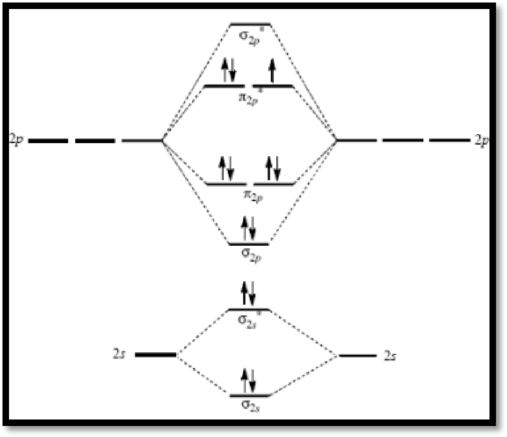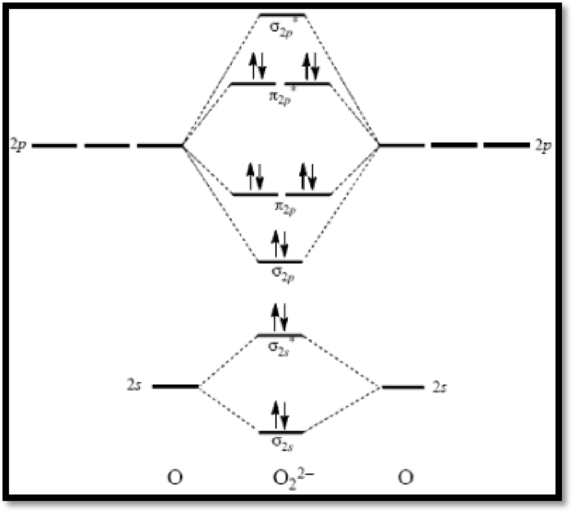
Concept explainers
(a)
Interpretation:
The molecular orbital diagram of
(a)
Explanation of Solution
The electronic configuration is,
The molecular orbital diagram of

Figure 1
The bond order of
The bond order of
The magnetic nature of
(b)
Interpretation:
The molecular property of oxygen that is explained by its molecular orbital diagram but not by Lewis structure has to be given.
(b)
Explanation of Solution
The molecular property of oxygen that is explained by its molecular orbital diagram is magnetic property.
The Lewis structure of oxygen is,

From the Lewis structure, it can be seen that all electrons are paired, and it is diamagnetic in nature. However, the molecular orbital diagram of oxygen (figure 1) shows the presence of two unpaired electrons and therefore, oxygen is paramagnetic.
(c)
Interpretation:
The nature of highest occupied molecular orbital in oxygen has to be given.
(c)
Explanation of Solution
The electronic configuration of oxygen in the ground state is
(d)
Interpretation:
The bond order and magnetic property in peroxide ion and superoxide ion has to be given.
(d)
Explanation of Solution
The formula of peroxide ion is
The formula of superoxide ion is
Superoxide ion
The molecular orbital diagram of

Figure 2
The bond order of
Superoxide ion
Peroxide ion
The molecular orbital diagram of

Figure 3
The bond order of
Peroxide ion
Want to see more full solutions like this?
Chapter 8 Solutions
ACHIEVE/CHEMICAL PRINCIPLES ACCESS 2TERM
- Beer’s Law is A = εbc, where A is absorbance, ε is the molar absorptivity (which is specific to the compound and wavelength in the measurement), and c is concentration. The absorbance of a 2.31 × 10-5 M solution of a compound is 0.822 at a wavelength of 266 nm in a 1.00-cm cell. Calculate the molar absorptivity at 266 nm.arrow_forwardHow to calculate % of unknown solution using line of best fit y=0.1227x + 0.0292 (y=2.244)arrow_forwardGiven a 1,3-dicarbonyl compound, state the (condensed) formula of the compound obtaineda) if I add hydroxylamine (NH2OH) to give an isooxazole.b) if I add thiosemicarbazide (NH2-CO-NH-NH2) to give an isothiazole.arrow_forward
- Complete the following acid-base reactions and predict the direction of equilibrium for each. Justify your prediction by citing pK values for the acid and conjugate acid in each equilibrium. (a) (b) NHs (c) O₂N NH NH OH H₁PO₁arrow_forward23.34 Show how to convert each starting material into isobutylamine in good yield. ཅ ནད ཀྱི (b) Br OEt (c) (d) (e) (f) Harrow_forwardPlease help me Please use https://app.molview.com/ to draw this. I tried, but I couldn't figure out how to do it.arrow_forward
- Propose a synthesis of 1-butanamine from the following: (a) a chloroalkane of three carbons (b) a chloroalkane of four carbonsarrow_forwardSelect the stronger base from each pair of compounds. (a) H₂CNH₂ or EtzN (b) CI or NH2 NH2 (c) .Q or EtzN (d) or (e) N or (f) H or Harrow_forward4. Provide a clear arrow-pushing mechanism for each of the following reactions. Do not skip proton transfers, do not combine steps, and make sure your arrows are clear enough to be interpreted without ambiguity. a. 2. 1. LDA 3. H3O+ HOarrow_forward
- b. H3C CH3 H3O+ ✓ H OHarrow_forward2. Provide reagents/conditions to accomplish the following syntheses. More than one step is required in some cases. a. CH3arrow_forwardIdentify and provide an explanation that distinguishes a qualitative and quantitative chemical analysis. Provide examples.arrow_forward
 Chemistry: Principles and PracticeChemistryISBN:9780534420123Author:Daniel L. Reger, Scott R. Goode, David W. Ball, Edward MercerPublisher:Cengage Learning
Chemistry: Principles and PracticeChemistryISBN:9780534420123Author:Daniel L. Reger, Scott R. Goode, David W. Ball, Edward MercerPublisher:Cengage Learning Chemistry by OpenStax (2015-05-04)ChemistryISBN:9781938168390Author:Klaus Theopold, Richard H Langley, Paul Flowers, William R. Robinson, Mark BlaserPublisher:OpenStax
Chemistry by OpenStax (2015-05-04)ChemistryISBN:9781938168390Author:Klaus Theopold, Richard H Langley, Paul Flowers, William R. Robinson, Mark BlaserPublisher:OpenStax

